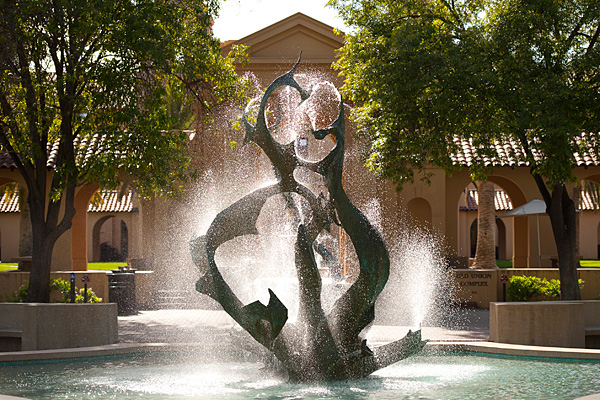Sculptor returns for update on White Plaza fountain makeover
Aristides Demetrios, who created the sculpture affectionately known as "The Claw" nearly 50 years ago, recently returned to campus to help "tune" the fountain's water jets. Step by step, university staff, from the machine shop to the museum, are working to restore the campus landmark to its former glory.

White Memorial Fountain – The Claw – was commissioned to honor two Stanford students, William N. White and John B. White II, brothers in the Class of 1949 who died in separate accidents before they graduated. Their parents, Mr. and Mrs. Raymond B. White, donated money for White Memorial Plaza and for the fountain.
As a machine shop crew, dressed in black waders and yellow rain slickers, sloshed around in White Memorial Fountain's shallow pool, sculptor Aristides "Aris" Demetrios walked around its perimeter to study the interplay of light and water.
It was a sunny day in early spring and the sculptor had returned to campus to fulfill a promise he made late last year to help the crew "tune" the fountain's water jets.
"Bring that jet up – just a little bit," he called out to plumber Gerald West, who pulled up the hood of his slicker, ducked his head and waded under the spray to adjust one of the more than five-dozen valves controlling the flow of water.
Occasionally, Demetrios and the crew – including machinists Spiros Vasilikos and Vince D'Amico – huddled at the edge of the pool to talk.
Their goal was to make sure every part of the copper-and-bronze sculpture – affectionately known as The Claw – was "watered."
The white-haired sculptor, who installed the sculpture in 1964, met the crew last August, after they invited him to campus to inspect the work they had done restoring the campus landmark. He returned in October for another consultation.
Since then, the machine shop had built a new stainless steel manifold with individual valves controlling each of the fountain's 65 jets. They covered it with a metal shroud to protect the valves from fountain-hopping students – a longtime Stanford tradition – and applied a black powder coating to make the manifold "disappear" from view. They also installed a new dome-shaped drain.
"It looks fantastic," the sculptor said, pausing in his rounds to contemplate the sculpture, his back to White Plaza. "See the droplets of water glistening in the sun in the center? They weren't there before. This is a ball and now the water expresses it."
Demetrios continued his walk around the fountain, then stopped again, his back to the Stanford Bookstore.
"Look at the water dance on top," he said. "It's full of life and spirit."
He also admired the work of the Cantor Arts Center, whose staff used an alcohol spray and soft bristle brushes to remove algae from the sculpture. This summer, the museum plans to remove – at the sculptor's request – the red paint at its top.
The paint is a remnant of an annual ritual by the Stanford Band, which impales a teddy bear – which represents Oski, mascot of the University of California-Berkeley – at the top of the fountain in the days leading up to the Big Game.
The capstone ledge that surrounds the pool, which is made of concrete embedded with tiny white, golden and amber stones, also has been restored.
The final step in the restoration project will take place this summer, when the crew replaces the damaged – and dulled – black-and-white edging framing the pool.
Mitch Bousson, Stanford's architectural trades and fleet manager, said the university has hired a lighting consultant to discuss ways to illuminate the beloved fountain.
"We are planning a celebration after the new concrete is installed around The Claw and the lighting is in," he said. "Possible late July or early August."

Share This Story